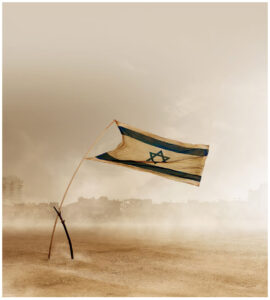Images, like words, are messages.
This is exemplified by the cover illustration of The Economist for March 23, 2024, which shows the flag of Israel, somewhere in Gaza, illustrating the theme of the magazine’s lead editorial, “At a moment of military might, Israel looks deeply vulnerable”. Here it is:
The flag – the flag of the Jewish nation – is tied to a wavering flagpole that is hesitantly supported by a random, leafless limb. The flag stands within the center of a barren field. A row of demolished buildings – were they once shops? – had they been peoples’ homes? – were they apartments? – were they once prisons for Jews taken captive by “palestinians” on October 7, 2023? – form a random, apocalyptic horizon in the background. And, wind: wind everywhere. The photo shows wind; it speaks of wind; it screams “wind”. Clouds of dust rest upon the earth even as they billow and rise from it, to obscure both sky and the works of man. And withal, signs of life are absent from the photo.
The image (aesthetically and symbolically, it’s very evocative) conveys barrenness and desolation, and its central message is that of Israel’s isolation, while – by virtue of the flag being bedraggled; besmeared by dust; unkempt and forlorn – the Jewish state is not at its best; its future uncertain. This is consistent with the message of The Economist’s editorial, which with astonishing stupidity (or mendacity disguised as altruism?) advocates for a “two-state solution”, and warns of Israel being, “…locked in the bleakest trajectory of its 75-year existence, featuring endless occupation, hard-right politics and isolation.”
So superficially, the photo succeeds.
But on a deeper level, it inadvertently succeeds – Balaam-like – in a way that the editors of The Economist neither anticipated or intended, for it is an image not of ambivalence, but the possibility of victory.
And so I quote, from chapter 23 of the Book of Numbers (English from Chabad.org, Hebrew from Sefaria.org):
VII
וַיִּשָּׂ֥א מְשָׁל֖וֹ וַיֹּאמַ֑ר מִן־אֲ֠רָ֠ם יַנְחֵ֨נִי בָלָ֤ק מֶֽלֶךְ־מוֹאָב֙ מֵֽהַרְרֵי־קֶ֔דֶם לְכָה֙ אָֽרָה־לִּ֣י יַעֲקֹ֔ב וּלְכָ֖ה זֹעֲמָ֥ה יִשְׂרָאֵֽל׃
He took up his parable and said,
“Balak the king of Moab has brought me from Aram,
from the mountains of the east [saying],
‘Come, curse Jacob for me and come invoke wrath against Israel.’
VIII
מָ֣ה אֶקֹּ֔ב לֹ֥א קַבֹּ֖ה אֵ֑ל וּמָ֣ה אֶזְעֹ֔ם לֹ֥א זָעַ֖ם יְהֹוָֽה׃
How can I curse whom God has not cursed,
and how can I invoke wrath if the Lord has not been angered?
IX
כִּֽי־מֵרֹ֤אשׁ צֻרִים֙ אֶרְאֶ֔נּוּ וּמִגְּבָע֖וֹת אֲשׁוּרֶ֑נּוּ הֶן־עָם֙ לְבָדָ֣ד יִשְׁכֹּ֔ן וּבַגּוֹיִ֖ם לֹ֥א יִתְחַשָּֽׁב׃
For from their beginning,
I see them as mountain peaks,
and I behold them as hills;
it is a nation that will dwell alone,
and will not be reckoned among the nations.
X
מִ֤י מָנָה֙ עֲפַ֣ר יַעֲקֹ֔ב וּמִסְפָּ֖ר אֶת־רֹ֣בַע יִשְׂרָאֵ֑ל תָּמֹ֤ת נַפְשִׁי֙ מ֣וֹת יְשָׁרִ֔ים וּתְהִ֥י אַחֲרִיתִ֖י כָּמֹֽהוּ׃
Who counted the dust of Jacob or the number of a fourth of [or, of the seed of] Israel?
May my soul die the death of the upright and let my end be like his.”
XI
וַיֹּ֤אמֶר בָּלָק֙ אֶל־בִּלְעָ֔ם מֶ֥ה עָשִׂ֖יתָ לִ֑י לָקֹ֤ב אֹיְבַי֙ לְקַחְתִּ֔יךָ וְהִנֵּ֖ה בֵּרַ֥כְתָּ בָרֵֽךְ׃
Balak said to Balaam, “What have you done to me?
I took you to curse my enemies,
but you have blessed them!”
XII
וַיַּ֖עַן וַיֹּאמַ֑ר הֲלֹ֗א אֵת֩ אֲשֶׁ֨ר יָשִׂ֤ים יְהֹוָה֙ בְּפִ֔י אֹת֥וֹ אֶשְׁמֹ֖ר לְדַבֵּֽר׃
He answered, saying,
“What the Lord puts into my mouth that I must take care to say.”
For while the Jewish flag struggles to reman attached; struggles against the wind; struggles to remain aloft, more than merely Sisyphus-like, it actually succeeds. The photo conveys Israel’s ability – if it will only allow itself – to stand tall, live, and continue, apart from the nations of the world, whether they be enemies or frenemies.

